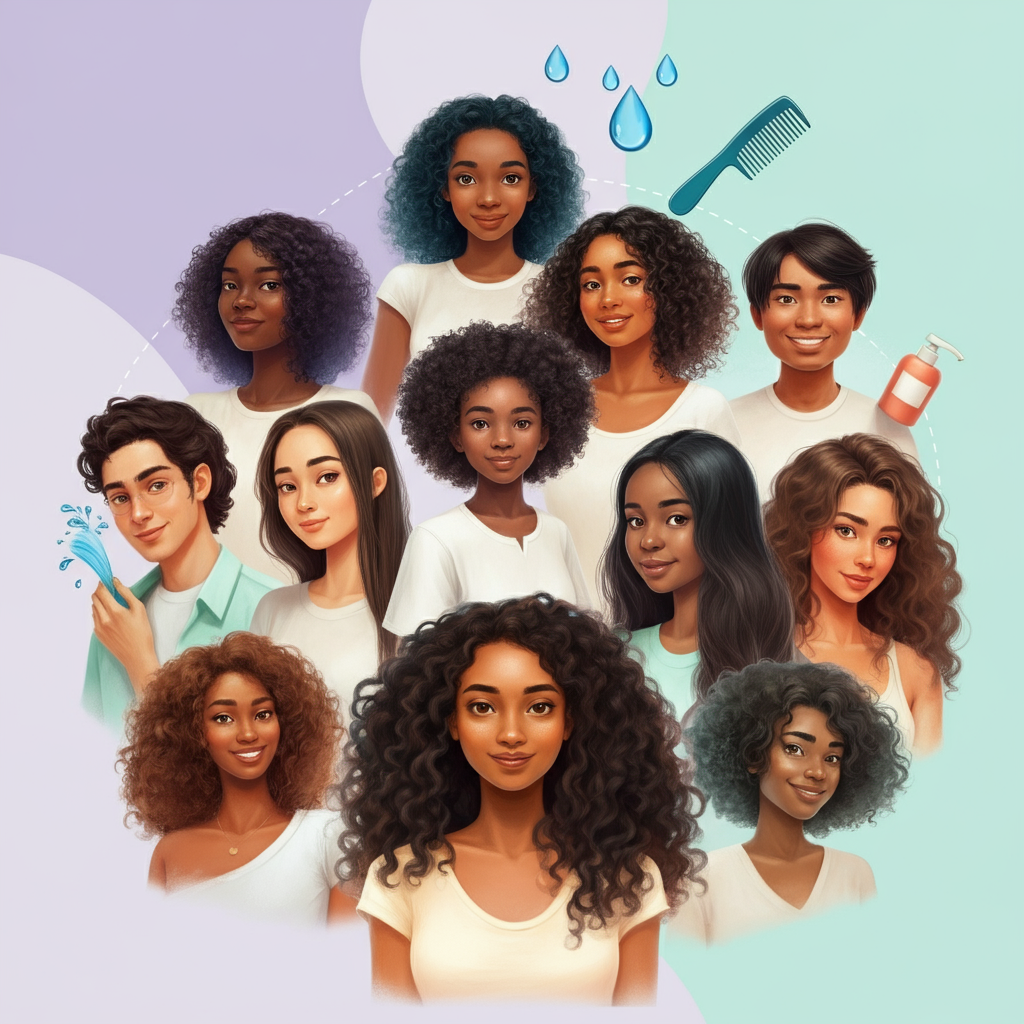
Introduction
Having a shelf full of expensive hair products that don’t seem to work can be incredibly frustrating. You follow the tutorials, you buy the recommended items, yet your hair remains frizzy, flat, or dry. The issue might not be the products themselves, but rather that they aren’t right for your hair. Just like skincare, a one-size-fits-all approach to hair care is destined to fail. The secret to unlocking a truly effective and healthy hair routine lies in understanding three fundamental aspects of your mane: its type, texture, and porosity.
Figuring out these key traits is the first step toward a personalized hair care plan that caters to your unique needs. When you know how your hair behaves—how it curls, how thick its individual strands are, and how well it absorbs moisture—you can finally choose products that will nourish and support it. This guide will walk you through simple, at-home methods to decode your hair’s identity. By the end, you’ll be equipped with the knowledge to stop guessing and start building a routine that promotes true hair health.
Why Identifying Your Hair Type Matters
Have you ever borrowed a friend’s “miracle” shampoo only to find it left your hair greasy or, conversely, feeling like straw? This common experience highlights a critical truth: your hair’s unique characteristics dictate what it needs. Using products formulated for a different hair type is one of the most frequent hair care mistakes. It can lead to a cycle of bad hair days and, over time, can cause significant damage.
When you use products that aren’t a good match, you’re working against your hair’s natural tendencies. For instance, applying a heavy, oil-based cream designed for coily hair to fine, straight hair will almost certainly weigh it down, making it look limp and oily. On the other hand, using a lightweight, volumizing spray on high-porosity, curly hair will likely do nothing to control frizz or provide the deep moisture it craves. This mismatch doesn’t just affect styling; it can strip hair of its natural oils, cause product buildup on the scalp, or lead to breakage from lack of proper hydration.
Creating a custom hair routine based on your specific profile is essential for achieving your goals, whether that’s enhanced shine, better curl definition, or more volume. Understanding your hair is also foundational for effective hair growth tips. When your scalp is healthy and your strands are properly nourished, you create the ideal environment for your hair to grow stronger and more resilient. Taking the time to identify your hair’s needs is an investment that pays off with healthier, more manageable, and more beautiful hair.
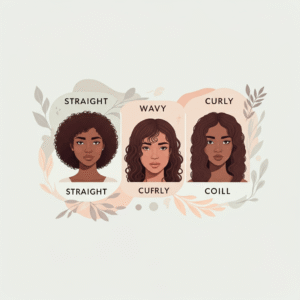
How to Determine Your Hair Type
Hair type is primarily determined by your follicle shape, which dictates the curl pattern of your hair. While it can seem complex, it’s generally categorized into four main types, with sub-classifications that describe the tightness of the wave or curl. Let’s break down the Andre Walker Hair Typing System, the most widely used method for classification.
To determine your type, wash your hair and let it air dry completely without any products. Observe its natural shape and pattern. Does it lie flat? Does it have a gentle “S” shape? Are the curls tight and springy? Compare your observations to the descriptions below.
Straight Hair (Type 1)
If your hair dries without any bend or curl, you have Type 1 hair. The strands can be fine or coarse, but they hang straight from root to tip.
- Characteristics: Straight hair is the most resilient type and tends to be very shiny. This is because the scalp’s natural oils (sebum) can easily travel down the straight hair shaft, keeping it moisturized.
- Challenges: This same quality can be a downside. Straight hair often becomes oily faster than other types. It can also be difficult to hold a curl and may lack volume, appearing flat.
- Care Tips: Avoid heavy, cream-based products. Opt for lightweight shampoos, conditioners, and volumizing sprays. Dry shampoo will be your best friend to absorb excess oil between washes. To add texture, use texturizing sprays or a light mousse.
Wavy Hair (Type 2)
Wavy hair forms a natural “S” shape. It’s the middle ground between straight and curly, with more texture than Type 1 but a looser pattern than Type 3. It’s subdivided into three categories:
- Type 2A: Fine, barely-there waves. The hair is mostly straight at the roots and forms a gentle, tousled wave toward the ends. It’s easily weighed down.
- Type 2B: The “S” shape is more defined and starts lower down the hair shaft. This type is more prone to frizz, especially at the crown.
- Type 2C: The waves are more distinct and begin closer to the scalp. The “S” pattern is tight, and some individual strands may even form loose spiral curls. This type is the most prone to frizz within the wavy category.
- Signs and Maintenance: If your hair isn’t stick-straight but doesn’t form tight curls, it’s likely wavy. The biggest challenge is finding a balance—moisturizing enough to combat frizz without weighing down the waves. Use anti-frizz serums and light curl creams. “Plopping” your hair in a t-shirt after washing can enhance your natural wave pattern.
Curly Hair (Type 3)
Curly hair is characterized by strands that form defined, springy curls or loops. Unlike wavy hair, where the pattern is an “S,” curly hair forms full circles. This type is often voluminous but can be prone to dryness and frizz.
- Type 3A: Large, loose curls that are about the size of a piece of sidewalk chalk. They are well-defined and have a lot of shine but can lose their shape.
- Type 3B: Springy, tighter curls that are about the size of a Sharpie marker. This type has good volume but can be frizzier.
- Type 3C: Tight, densely packed, corkscrew-like curls about the size of a pencil. This creates a lot of volume, but the strands are prone to significant shrinkage and dryness.
- Common Problems and Solutions: The primary challenge for curly hair care is maintaining moisture. The tight curl pattern makes it difficult for the scalp’s natural oils to travel down the hair shaft. This leads to dryness, frizz, and breakage. Avoid shampoos with sulfates, which strip moisture. Instead, co-washing (washing with conditioner only) or using a moisturizing shampoo is ideal. Leave-in conditioners, deep conditioning treatments, and curl creams are essential for definition and hydration.
Coily/Kinky Hair (Type 4)
Coily hair, also known as kinky or Afro-textured hair, features the tightest curl pattern. The hair can appear shorter than it is due to “shrinkage.” It is the most fragile of all hair types and requires a dedicated care routine to maintain its health.
- Type 4A: Tightly coiled “S” patterned curls that are about the size of a crochet needle. The coils are visible and defined.
- Type 4B: Strands have a “Z” shape with sharp angles instead of a defined curl pattern. The hair is densely packed and can experience up to 75% shrinkage.
- Type 4C: Similar to 4B but even more tightly coiled and without a defined pattern. The strands are extremely delicate and prone to breakage.
- Special Care Requirements: Moisture is paramount. This hair type benefits from rich, thick creams, butters, and oils. The LOC (Liquid, Oil, Cream) or LCO (Liquid, Cream, Oil) method is popular for sealing in moisture. Protective styles, like braids or twists, can help minimize manipulation and breakage. Regular deep conditioning and protein treatments are necessary to maintain strength.
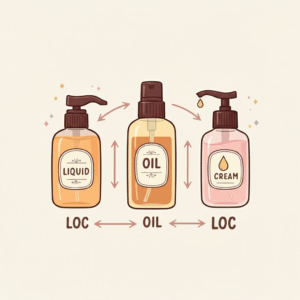
A hair type chart can be a useful visual aid. You can find many examples online by searching for “Andre Walker Hair Type Chart” to help you pinpoint where your hair falls. When comparing, remember that it’s common to have a mix of two or more hair types on your head.
Understanding Hair Texture
While hair type describes your curl pattern, hair texture refers to the thickness or circumference of each individual hair strand. You can have fine curly hair, coarse straight hair, or any combination. Texture determines how well your hair holds styles and how it reacts to products. Knowing your texture is a key component of a custom hair routine.
There are three main categories of hair texture: fine, medium, and coarse.
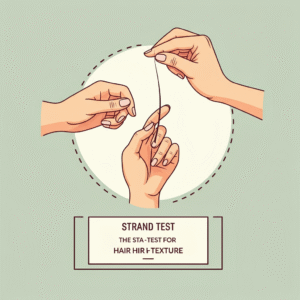
DIY Test: Rolling One Strand Between Your Fingers
The easiest way to determine your hair texture is to take a single strand of hair from your brush or comb. Make sure it’s clean and free of product. Roll the strand between your thumb and index finger.
- Fine Hair: If you can barely feel the strand or don’t feel it at all, you have fine hair.
- Medium Hair: If you can feel the strand easily, you have medium hair. It feels like a piece of cotton thread.
- Coarse Hair: If the strand feels thick, wiry, and very noticeable, you have coarse hair.
Best Styling and Product Recommendations
Fine Hair Care:
Fine hair has the smallest circumference and is the most delicate. It’s easily weighed down by heavy products, making it look limp and greasy. It’s also more prone to breakage.
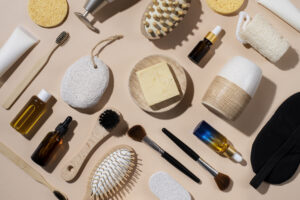
- Styling: Styles that create volume are best. Blow-drying with a round brush can add lift at the roots. However, be cautious with heat, as fine hair is easily damaged.
- Products: Look for “volumizing” or “thickening” labels. Lightweight mousses, texturizing sprays, and clarifying shampoos are excellent choices. Avoid heavy oils, butters, and silicone-heavy conditioners.
Medium Hair Texture:
Medium hair is the most common texture. It’s thicker than fine hair but not as wiry as coarse hair. It’s relatively easy to style and holds its shape well.
- Styling: This texture is very versatile. It can hold curls, be straightened, and supports a wide range of styles without much trouble.
- Products: You have a lot of flexibility. You can use a variety of products, from lightweight lotions to moderate creams, depending on your hair’s other needs (like porosity and type). It benefits from regular deep conditioning to maintain its health.
Coarse Hair Care:
Coarse hair has the largest circumference. Each strand is thick and strong. While it’s more resistant to damage, it can also be resistant to styling and chemical treatments. It often feels dry and wiry.
- Styling: Coarse hair holds styles very well but can be difficult to manipulate. It can handle higher heat settings, but heat protectant is still a must.
- Products: This texture needs products that provide significant moisture. Look for rich, hydrating conditioners, deep conditioning masks, hair butters, and oils. These products will help soften the strands and make them more manageable.
Hair Porosity — What It Means and How to Test It
Hair porosity is a term you might hear a lot in the natural hair products community, and for good reason. It’s a crucial piece of the puzzle. Porosity refers to your hair’s ability to absorb and retain moisture. It’s determined by the structure of your hair’s cuticle, which is the outermost layer. Think of the cuticle like shingles on a roof. They can be tightly packed, slightly raised, or wide open.
- Low Porosity: The cuticles are very tight and flat. This makes it difficult for moisture to get in, but once it’s in, it’s also difficult for it to get out.
- Medium Porosity: The cuticles are slightly raised, allowing moisture to enter and exit at a steady, moderate pace. This is considered the ideal porosity.
- High Porosity: The cuticles are widely spaced with gaps and holes. Moisture gets in easily, but it escapes just as quickly.
Porosity can be genetic, but it can also be altered by damage from heat, bleach, and chemical treatments, which can force the cuticles to remain open.
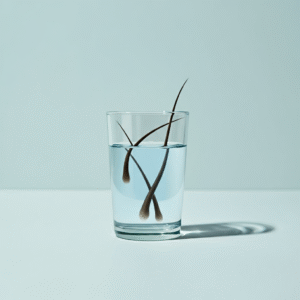
DIY Water Test: Step-by-Step Guide
The most popular at-home method to test your hair’s porosity is the float test.
- Get Clean Hair: Shampoo your hair to remove any product buildup. Silicones and oils can affect the results. Let it dry completely.
- Take a Strand: Pluck a clean, dry strand of hair.
- Drop it in Water: Fill a clear glass with room-temperature water and place the strand in the glass.
- Observe for 2-4 minutes:
- If your hair floats at the top, you have low porosity hair.
- If it sinks slowly or floats in the middle, you have medium porosity hair.
- If it sinks quickly to the bottom, you have high porosity hair.
Best Practices for Each Porosity Level
Low Porosity Hair:
- Challenge: Products tend to sit on top of the hair instead of being absorbed, leading to buildup. Hair takes a long time to dry.
- Best Practices: Use lightweight, liquid-based products. Look for humectants like glycerin or honey that attract moisture. Applying gentle heat with a steamer or hooded dryer when deep conditioning can help open the cuticles and allow moisture to penetrate. Use clarifying shampoos regularly to combat buildup. Conditioner for low porosity hair should be protein-free and applied to very wet hair to improve absorption.
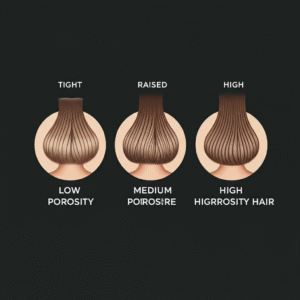
Medium Porosity Hair:
- Challenge: This is the easiest porosity to manage, but it can become damaged and more porous with frequent heat or chemical treatments.
- Best Practices: A balanced routine works best. You don’t need to go to extremes. Occasional deep conditioning and protein treatments will help maintain its health. Be mindful of heat and chemical processing to preserve your hair’s structure.
High Porosity Care:
- Challenge: Hair absorbs water quickly but dries just as fast, leading to frizz and chronic dryness. It’s often damaged and prone to breakage.
- Best Practices: The goal is to seal in moisture. Use anti-humectants (like silicone, though some prefer natural oils) to prevent frizz in humid weather. The LOC/LCO method is excellent for moisture retention hair. Layering a leave-in conditioner, a rich oil, and a cream helps to seal the cuticle. Protein treatments are also crucial to “patch up” the holes in the hair shaft, improving strength and moisture retention. Rinsing with cool water can help close the cuticles.
Matching Your Hair Profile to Products
Now that you’ve identified your hair’s type, texture, and porosity, it’s time to bring it all together. This complete profile is your roadmap to building a truly personalized hair care routine and selecting the right products. For example, you might have fine, Type 2A, high-porosity hair. This means you need moisture for the high porosity, but the products must be lightweight to avoid weighing down your fine waves. Someone else might have coarse, Type 4C, low-porosity hair, requiring rich emollients and techniques to help them penetrate the tight cuticles.
Creating your routine is about layering products that address each of your hair’s characteristics. Here is a table to serve as a starting point.
|
Hair Profile |
Shampoo |
Conditioner |
Styling Products |
|---|---|---|---|
|
Type 1 (Straight), Fine, Low Porosity |
Volumizing/Clarifying Shampoo |
Lightweight, Protein-Free Conditioner (applied to ends only) |
Mousse, Texturizing Spray, Dry Shampoo |
|
Type 2 (Wavy), Medium, Medium Porosity |
Sulfate-Free Moisturizing Shampoo |
Balancing Conditioner |
Light Curl Cream, Anti-Frizz Serum, Sea Salt Spray |
|
Type 3 (Curly), Coarse, High Porosity |
Co-Wash or Creamy Hydrating Shampoo |
Rich Deep Conditioner, Protein-Based Conditioner |
Leave-In Conditioner, Best shampoo for curly hair, Thick Curl Cream, Gel, Oil |
|
Type 4 (Coily), Coarse, Low Porosity |
Clarifying Shampoo (periodically), Moisturizing Shampoo |
Lightweight Hydrating Conditioner, use steam for deep conditioning |
Water-Based Leave-In, Light Oils (jojoba, argan), Styling Foam |
Remember, this is a general guide. The world of natural hair products is vast, and you may need to experiment. Pay attention to ingredients. For high-porosity hair, look for hydrolyzed proteins. For low-porosity, steer clear of heavy butters like shea unless they are whipped into a lighter formulation.
Common Myths About Hair Types
Misinformation about hair care is everywhere. Busting these myths can free you from unhelpful practices and bad products. Here are a few hair myths debunked.
- Myth: “Curly hair grows slower than straight hair.”
- Fact Check: All hair grows at roughly the same rate—about half an inch per month on average. The illusion that curly hair grows slower is due to “shrinkage.” A coily strand might grow six inches but only appear three inches long because of its tight curl pattern. This is why length retention, by preventing breakage, is so crucial for curly types.
- Myth: “You should brush your hair 100 times a day for shine.”
- Fact Check: This is one of the oldest and most damaging myths. Over-brushing, especially when hair is dry, causes friction that lifts the cuticle, leading to frizz and breakage. This is especially true for wavy, curly, and coily hair. For straight hair, gentle brushing can help distribute oils, but 100 strokes is excessive and harmful.
- Myth: “Oily hair doesn’t need a conditioner.”
- Fact Check: Oily hair is typically the result of an overactive scalp, not over-hydrated strands. Skipping conditioner can actually make the problem worse. When your hair is stripped of moisture (often by harsh shampoos meant to combat oil), your scalp may overcompensate by producing even more oil. The key is to use a lightweight conditioner and focus it on the mid-lengths and ends, avoiding the scalp.
- Myth: “Trimming your hair makes it grow faster.”
- Fact Check: Hair growth happens at the scalp, so cutting the ends has no physiological effect on the rate of growth. However, regular trims are vital for healthy hair facts. Trimming removes split ends, which, if left unchecked, can travel up the hair shaft and cause breakage. This breakage makes it seem like your hair isn’t growing. So, while trims don’t accelerate growth, they are essential for retaining length.
Conclusion
Embarking on the journey to understand your hair is a game-changer. By moving beyond generic advice and identifying your specific hair type, texture, and porosity, you empower yourself to make intelligent choices about your care and styling. You no longer have to be a victim of marketing claims or product trends that aren’t meant for you. Instead, you can become the expert of your own hair.
We encourage you to perform the simple tests outlined in this guide. Take a strand and feel its texture. Drop it in a glass of water and observe its porosity. Let it air dry and see its natural curl pattern emerge. Once you have your unique hair profile, you can start building a personalized hair care routine with intention. This is the foundation for achieving stronger, healthier, and more vibrant hair that you truly love. Your best hair days are not a matter of chance, but a result of knowledge and care.





Leave a Reply